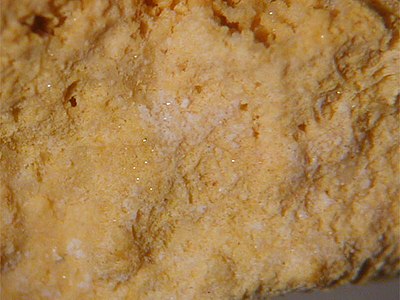Ferruccite
| Ferruccite | |
|---|---|
|
Ferruccite (white) on Avogadrite (yellowish brown) from Vesuvius , Italy (image width: 5 mm) |
|
| General and classification | |
| chemical formula | Na [BF 4 ] |
|
Mineral class (and possibly department) |
Halides |
|
System no. to Strunz and to Dana |
3.CA.05 ( 8th edition : III / B.01) 02/11/03/01 |
| Crystallographic Data | |
| Crystal system | orthorhombic |
| Crystal class ; symbol | orthorhombic-dipyramidal; 2 / m 2 / m 2 / m |
| Space group | Amma (No. 63, Position 3) |
| Lattice parameters | a = 6.79 Å ; b = 6.84 Å; c = 6.26 Å |
| Formula units | Z = 4 |
| Physical Properties | |
| Mohs hardness | 3 |
| Density (g / cm 3 ) | measured: 2.496; calculated: 2.5075 |
| Cleavage | good after {100}, {010} and {001} |
| colour | colorless, white |
| Line color | White |
| transparency | transparent to translucent |
| shine | Please complete |
| Crystal optics | |
| Refractive indices |
n α = 1.301 n β = 1.301 n γ = 1.307 |
| Birefringence | δ = 0.006 |
| Optical character | biaxial positive |
| Axis angle | 2V = measured: 11 °; calculated: 22 ° |
Ferruccite is a very rarely occurring mineral from the mineral class of " halides ". It crystallizes in the orthorhombic crystal system with the chemical composition Na [BF 4 ] and develops only very small, colorless to white, thin-tabular crystals or crusty coatings.
Etymology and history
Ferruccite was first discovered in 1933 on Vesuvius in Italy and described by Guido Carobbi (1900–1983), who named the mineral after the Italian mineralogist Ferruccio Zambonini (1880–1932).
Type material of the mineral is located at the ENSM in Paris (register no.CT : 8969 ), at the MMUFi in Florence (register no.HT : 1974 / I ) and at the NHM in London (register no.CT: BM 1933,419 ).
classification
In the now outdated, but still in use 8th edition of the mineral classification according to Strunz , ferruccite belonged to the mineral class of "halides" and there to the division of "anhydrous double halides", where it formed an independent group together with Avogadrite and Barberiite .
The 9th edition of Strunz's mineral systematics , which has been in effect since 2001 and is used by the International Mineralogical Association (IMA), also assigns ferruccite to the “halides” class, but in the “complex halides” department. This division is further subdivided according to the crystal structure, so that the mineral can be found according to its structure in the sub-division of "Borofluoride", where it is the only member of the unnamed group 3.CA.05 .
The systematics of minerals according to Dana , which is mainly used in the English-speaking world , assigns ferruccite to the “halides” class and there to the “complex halides - aluminum fluorides” division. Here he is the only member of the unnamed group 02/11/03 within the subdivision of " Complex halides (and aluminum fluorides) with the general composition (A) m B (X) 4 ".
Crystal structure
Ferruccite crystallizes orthorhombically in the space group Amma with the lattice parameters a = 6.79 Å ; b = 6.84 Å and c = 6.26 Å and 4 formula units per unit cell .
properties
Ferruccit is water-soluble and gives it a bitter, acidic taste.
Education and Locations
Ferruccite crystallizes directly ( sublimation ) from the volcanic gases of the active fumaroles . Accompanying minerals include sassolin and various fluoroborates and fluorosilicates .
So far (status: 2010) the mineral could only be found at its type locality Vesuvius and in the valley between Monte Somma and Vesuvius ( Atrio del Cavallo ).
See also
Web links
- Mineral Atlas: Ferruccite (Wiki)
Individual evidence
- ↑ a b c d e Hugo Strunz , Ernest H. Nickel : Strunz Mineralogical Tables. Chemical-structural Mineral Classification System . 9th edition. E. Schweizerbart'sche Verlagbuchhandlung (Nägele and Obermiller), Stuttgart 2001, ISBN 3-510-65188-X , p. 160 .
- ↑ Webmineral - Avogadrite (English)
- ↑ a b Ferruccite . In: John W. Anthony, Richard A. Bideaux, Kenneth W. Bladh, Monte C. Nichols (Eds.): Handbook of Mineralogy, Mineralogical Society of America . 2001 ( handbookofmineralogy.org [PDF; 67 kB ; accessed on April 9, 2018]).
- ↑ a b c d e Mindat - Ferruccite (English)
- ^ Mineral species of Vesuvius described for the first time. In: euromin.w3sites.net. Archived from the original on September 14, 2014 ; accessed on April 9, 2018 . (English)
- ↑ Carobbiite . In: John W. Anthony, Richard A. Bideaux, Kenneth W. Bladh, Monte C. Nichols (Eds.): Handbook of Mineralogy, Mineralogical Society of America . 2001 ( handbookofmineralogy.org [PDF; 59 kB ; accessed on April 9, 2018]; named after Professor Guido Carobbi (1900–1983), Italian geologist, Institute of Mineralogy and Geochemistry, University of Florence, Florence, Italy, who collected the first specimens. ).
- ↑ Centro Musei delle Scienze Naturali - Ferruccio Zambonini (Italian)
- ↑ Catalog of Type Mineral Specimens - F. (PDF 73 kB) In: docs.wixstatic.com. Commission on Museums (IMA), December 12, 2018, p. 7 , accessed August 29, 2019 .
